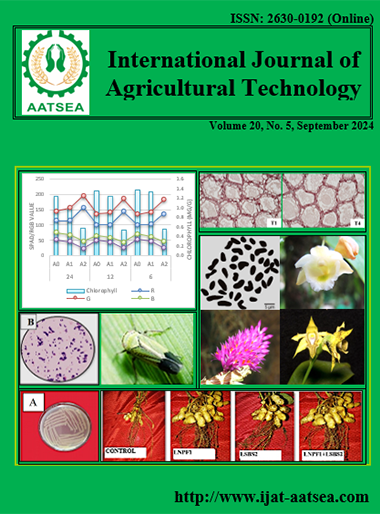Growth and yield performance of different maize growth stages subjected to waterlogging
Main Article Content
Abstract
Waterlogging in various maize growth stages significantly reduces plant height and dry matter and extends the vegetative phase, delaying days to anthesis, silking, and harvest maturity. Effects persist post-stress, with noticeable root and shoot dry weight reductions, indicating incomplete recovery. Older growth stages show resilience to waterlogging's impact on the reproductive cycle. Consistently, waterlogging prolongs harvest maturity due to reproductive phase delays, especially in early growth stages or with repeated incidents. Waterlogging occurs several times in a life cycle, and the early seedling stage has the most adverse effects on yield-related traits, leading to extended anthesis-silking intervals, decreased grain yield, and increased barrenness in maize. The highest yield loss occurs with early growth stage waterlogging, emphasizing the enhanced resilience of older growth stages. Waterlogging stress had detrimental effects on growth, development, and maize yield, with the early growth stages and the repeated stress episodes posing the most significant risks to maize productivity.
Article Details

This work is licensed under a Creative Commons Attribution-NonCommercial-NoDerivatives 4.0 International License.
References
Bhan, H. (1977). Effect of water-logging on maize. The Indian Journal of Agricultural Research, 11:147-150.
Esteban, J. A. C. and Edwin I. S. (2016). Waterlogging: Its effects on different white maize genotypes. International Journal of Sciences: Basic and Applied Research, 30:112-120.
Esteban, J. A. C. and Baldo, N. B. (2023). Screening of waterlogging-tolerant maize (Zea mays Linn.) at early seedling stage. Agriculture and Natural Resources, 57:437-444.
Esteban, J. A. C. and Baldo, N. B. (2024). Effects and Recovery of Maize (Zea mays Linn) to Waterlogging Imposed at Early Seedling Stage. Agricultural Science Digest. doi: 10.18805/ag.DF-500.
Gazal, A., Nehvi, F., Lone, A. A. and Dar, Z. A. (2017). Assessment of genetic variability of a set of maize inbred lines for drought tolerance under temperate conditions. International Journal of Current Microbiology and Applied Sciences, 6:2380-2389.
Howell, T. A. and Hiler, E. A. (1974). Effects of inundation period on seedling growth. Transactions of the ASAE, 17:286-288,294.
Kaur, G., Zurweller, B. A., Nelson, K. A., Motavalli, P. P. and Dudenhoeffer, C. J. (2019). Soil waterlogging and nitrogen fertilizer management effects on corn and soybean yields. Agronomy Journal, 109: 97-106.
Li, J. C., Wei, F. Z., Wang, C. Y. and Yin, J. (2006). Effects of waterlogging on senescence of root system at booting stage in winter wheat. Acta Agronomica Sinica, 32:1355-1360. Retrieved from https://europepmc.org/abstract/cba/625085
Liu, Y. Z., Tang, B., Zheng, Y. L., Ma, K. J., Xu, S. Z. and Qiu, F. Z. (2010). Screening methods for waterlogging tolerance at maize (Zea mays l.) seedling stage. Agricultural Sciences in China, 9: 362-369.
Lone, A. A., Khan, M. H., Dar, Z. A. and Wani, S. H. (2018). Breeding strategies for improving growth and yield under waterlogging conditions in maize: a review. Maydica, 61:11.
Lone, A. A. and Warsi, M. Z. K. (2009). Response of maize (Zea mays L.) to excess soil moisture (ESM) tolerance at different stages of life cycle. Botany Research International, 2:211-217.
Kanwar, R. S., Baker, J. L. and Mukhtar, S. (1988). Excessive soil water effects at various stages of development on the growth and yield of com. Transactions of the ASAE, 31:133-141.
Mason, W. K, Pritchard, K. E. and Small, D. R. (1987). Effect of the early season water logging on maize growth and yield. Australian Journal of Agricultural Research, 38:27-35.
Paril, J. F., Sanchez, M. A. B. and Salazar, A. M. (2017). Genomic selection in maize population improvement for water logging tolerance. Philippine Journal of Crop Science, 39:120-121.
Rathore, T., Warsi, M., Singh, N. and Vasal, S. (1998). Production of maize under excess soil moisture (waterlogging) conditions. In Proceedings of the 2nd Asian Regional Maize Workshop PCAARRD, Los Banos, Philippines, 23 February; pp.23-27.
Ren, B., Zhang, J., Dong, S., Liu, P. and Zhao, B. (2016). Efects of waterlogging on leaf mesophyll cell ultrastructure and photosynthetic characteristics of summer maize. PLoS ONE 11:e0161424.
Ren, B., Zhang, J.W., Li, X., Fan, X., Dong, S., Liu, P. and Zhao, B. (2014). Effects of waterlogging on the yield and growth of summer maize under field conditions. Canadian Journal of Plant Science. 94:23-31.
Rubinigg, M., Stulen, I., Elzenga, J. T. M. and Colmer, T. D. (2002). Spatial patterns of radial oxygen loss and nitrate net flux along adventitious roots of rice raised in aerated or stagnant solution. Functional Plant Biology, 29:1475-1481.
Shiferaw, B., Prasanna, B. M., Hellin, J. and Bänziger, M. (2011). Crops that feed the world 6. Past successes and future challenges to the role played by maize in global food security. Food Security, 3:307.
Shin, S., Kim, S., Jung, G., Kim, C., Son, B., Kim, J. T., Kim, S. G., Yang, W., Kwon, Y., Shim, K. and Woo, M. (2016). Evaluation of waterlogging tolerance with the degree of foliar senescence at early vegetative stage of maize (Zea mays L.). Journal Crop Science Biotechnology. 19:393-399.
Tian, L. X., Bi, W-s., Ren, X-s., Li, W-l., Sun, L. and Li, J. (2020). Flooding has more adverse efects on the stem structure and yield of spring maize (Zea mays L.) than waterlogging in northeast China. European Society for Agronomy, 117:126054.
Zaidi, P. H., Mehrajuddin, M. L., Jat, K., Pixley, R. P. and Singh, S. D. (2009). Resilient maize for improved and stable productivity of rain-fed environment of South and Southeast Asia. Maize for Asia - Emerging Trends and Technologies. Proc. 10th Asian Regional Maize Workshop, 20-23 October, 2008, Makassar, Indonesia (in press).


